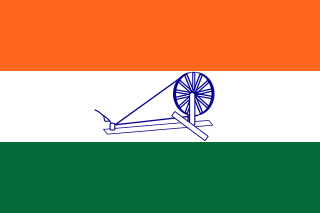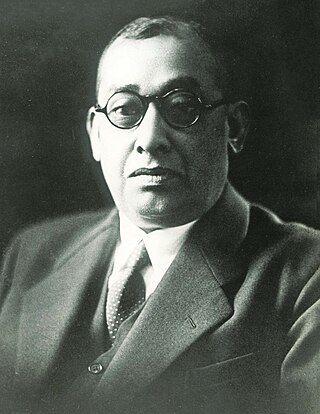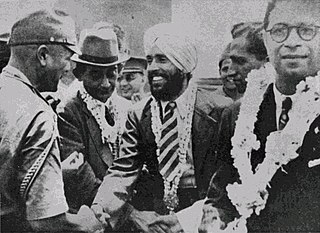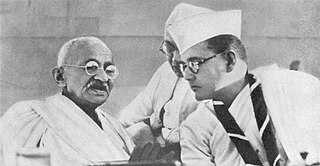Related Research Articles

The Indian National Army was an armed force formed in Southeast Asia during World War II; it comprised British Indian Army prisoners of war taken by the Empire of Japan and enlisting civilians, mostly Tamils in Southeast Asia; it was led by Indian nationalist Subhas Chandra Bose after he arrived in Southeast Asia in May 1943 with a view to liberating India from British rule by force of arms; it furnished support to the Imperial Japanese Army during its unsuccessful attack on British India.

Subhas Chandra Bose was an Indian nationalist whose defiance of British authority in India made him a hero among many Indians, but his wartime alliances with Nazi Germany and Fascist Japan left a legacy vexed by authoritarianism, anti-Semitism, and military failure. The honorific 'Netaji' was first applied to Bose in Germany in early 1942—by the Indian soldiers of the Indische Legion and by the German and Indian officials in the Special Bureau for India in Berlin. It is now used throughout India.

The Provisional Government of Free India or, more simply, Azad Hind, was a short-lived Japanese-controlled provisional government in India. It was established in Japanese occupied Singapore during World War II in October 1943 and has been considered a puppet state of the Empire of Japan.

Rash Behari Bose was an Indian revolutionary leader and freedom fighter who fought against the British Empire. He was one of the key organisers of the Ghadar Mutiny and founded the Indian Independence League. Bose also led the Indian National Army (INA) which was formed in 1942 under Mohan Singh.

Mohan Singh was a British Indian Army officer, and later member of the Indian Independence Movement, best known for founding and leading the Indian National Army in South East Asia during World War II. Following Indian independence, Mohan Singh later served in public life as a Member of Parliament in the Rajya Sabha of the Indian Parliament.

Subhas Chandra Bose, also known as Netaji, his political views were in support of complete freedom for India with a classless society and state socialism at the earliest, whereas most of the Congress Committee wanted it in phases, through a Dominion status.
The Indian Independence League was a political organisation operated from the 1920s to the 1940s to organise those living outside British India into seeking the removal of British colonial rule over the region. Founded by Indian nationalists, its activities were conducted in various parts of Southeast Asia. It included Indian expatriates, and later, Indian nationalists in-exile under Japanese occupation following Japan's successful Malayan Campaign during the first part of the Second World War. During the Japanese Occupation of Malaya, the Japanese encouraged Indians in Malaya to join the League.

Fujiwara kikan was a military intelligence operation established by the IGHQ in September 1941. The Unit was transferred to Bangkok at the end of that month and headed by Major Fujiwara Iwaichi, chief of intelligence of the 15th army. Its task was to contact the Indian independence movement, the overseas Chinese and the Malayan Sultans with the aim of encouraging friendship and cooperation with Japan. The unit was notable for its success in establishing cooperative ties between the Empire of Japan and the Indian independence movement, overseas Chinese and various Malay sultans.
The Bidadari Resolutions were set of resolutions adopted by the nascent Indian National Army in April 1942 that declared the formation of the INA and its aim to launch an armed struggle for Indian independence. The resolution was declared at a prisoner-of-war camp at the Bidadari in Singapore during Japanese occupation of the island.
The Ghadar Mutiny, also known as the Ghadar Conspiracy, was a plan to initiate a pan-India mutiny in the British Indian Army in February 1915 to end the British Raj in India. The plot originated at the onset of World War I, between the Ghadar Party in the United States, the Berlin Committee in Germany, the Indian revolutionary underground in British India and the German Foreign Office through the consulate in San Francisco. The incident derives its name from the North American Ghadar Party, whose members of the Punjabi community in Canada and the United States were among the most prominent participants in the plan. It was the most prominent amongst a number of plans of the much larger Hindu–German Mutiny, formulated between 1914 and 1917 to initiate a Pan-Indian rebellion against the British Raj during World War I. The mutiny was planned to start in the key state of Punjab, followed by mutinies in Bengal and rest of India. Indian units as far as Singapore were planned to participate in the rebellion. The plans were thwarted through a coordinated intelligence and police response. British intelligence infiltrated the Ghadarite movement in Canada and in India, and last-minute intelligence from a spy helped crush the planned uprising in Punjab before it started. Key figures were arrested, and mutinies in smaller units and garrisons within India were also crushed.
K. P. Keshava Menon (1884?–?) was an Indian lawyer and a leading Indian independence activist from Kerala who was a key proponent of the formation of the Indian Independence League (IIL) and a lawyer for the Indian National Army (INA).
Jiffs was a slang term used by British Intelligence, and later the 14th Army, to denote soldiers of the Indian National Army after the failed First Arakan offensive of 1943. The term is derived from the acronym JIFC, short for Japanese-Indian fifth column. It came to be employed in a propaganda offensive in June 1943 within the British Indian Army as a part of the efforts to preserve the loyalty of the Indian troops at Manipur after suffering desertion and losses at Burma during the First Arakan Offensive. After the end of the war, the term "HIFFs" was also used for repatriated troops of the Indian Legion awaiting trial.
The First Indian National Army was the Indian National Army as it existed between February and December 1942. It was formed with Japanese aid and support after the Fall of Singapore and consisted of approximately 12,000 of the 40,000 Indian prisoners of war who were captured either during the Malayan campaign or surrendered at Singapore. It was formally proclaimed in April 1942 and declared the subordinate military wing of the Indian Independence League in June that year. The unit was formed by Mohan Singh. The unit was dissolved in December 1942 after apprehensions of Japanese motives with regards to the INA led to disagreements and distrust between Mohan Singh and INA leadership on one hand, and the League's leadership, most notably Rash Behari Bose. Later on, the leadership of the Indian National Army was handed to Subhas Chandra Bose. A large number of the INAs initial volunteers, however, later went on to join the INA in its second incarnation under Subhas Chandra Bose.
The Farrer Park address was an assembly of the surrendered Indian troops of the British Indian Army held at Farrer Park in Singapore on 17 February 1942, two days after the Fall of Singapore. The assembly was marked by a series of three addresses in which the British Malaya Command formally surrendered the Indian troops of the British Indian Army to Major Fujiwara Iwaichi representing the Japanese military authority, followed by transfer of authority by Fujiwara to the command of Mohan Singh, and a subsequent address by Mohan Singh to the gathered troops declaring the formation of the Indian National Army to fight the Raj, asking for volunteers to join the army.

Vishnu Ganesh Pingle was an Indian revolutionary and a member of the Ghadar Party who was one of those executed in 1915 following the Lahore conspiracy trial for his role in the Ghadar conspiracy.
Prafulla Kumar Sen, also known as Swami Satyananda Puri, was an Indian revolutionary and philosopher. Puri, had in his youth taught Oriental philosophy at the University of Calcutta and later at Rabindranath Tagore's Visva-Bharati University at Santiniketan. Encouraged by Tagore, he arrived in Thailand in 1932, and in 1939, he founded the Thai-Bharat Lodge, a cultural forum. Arriving in Thailand, Puri was appointed a professor at the Chulalongkorn University, lecturing in ancient Indian and Thai languages, and is said to have mastered the Thai Language in six months and went on to translate a number of Indian philosophical works and biographies, including the Ramayana and biographies of Gandhi to Thai. His literary work eventually was more than twenty volumes.
The Indian National Council was an organisation founded in December 1941 in Bangkok by Indian Nationalists residing in Thailand. The organisation was founded from the Thai-Bharat Cultural Lodge on 22 December 1941. The founding president of the Council was Swami Satyananda Puri, along with Debnath Das as the founding secretary. Along with the Indian Independence League, it came to be one of the two prominent Indian associations that corresponded with I Fujiwara's F Kikan on the scopes of Japanese assistance to the Indian movement.
The Tokyo Conference was a conference held between March 28 and 30, 1942 at Tokyo by South-East Asian Indian Nationalist groups including the Indian Independence League, the Indian National Council, and smaller local Indian associations and clubs. This conference led to the decision to establish an all-unifying Indian Independence League. The conference was held at the invitation of Rash Behari Bose who was instrumental in persuading the Japanese authorities to stand by the Indian nationalists and ultimately to support actively the Indian freedom struggle abroad. Bose was also elected the leader of the Indian movement in South-East Asia during this conference. However, the Tokyo conference failed to reach any definitive decisions due to the differences between various regional factions, and also because of differences both with Rash Behari especially given his long connection with Japan and the current position of Japan as the occupying power in South-east Asia, and also because many were wary of vested Japanese interests. The Tokyo conference however, did agree on the decision to meet again in Bangkok to establish an all-unifying IIL at a future date. Rash Behari arrived in Singapore in April with the returning Indian delegation.

Habib-ur-Rahman (1913–1978) was an army officer in the Indian National Army (INA) who was charged with "waging war against His Majesty the King Emperor". He served as Subhas Chandra Bose's chief of staff in Singapore, and accompanied Bose on his alleged last fatal flight from Taipei to Tokyo, sharing the last moments of his life. Rahman also played an important role in the First Kashmir War. Convinced that Maharaja Hari Singh was out to exterminate the Muslims of Jammu and Kashmir, he joined Major General Zaman Kiani, in launching a rebellion against the Maharaja from Gujrat in Pakistani Punjab. Rehman and his volunteer force launched an attack on the Bhimber town. But, the records of the 11th Cavalry of the Pakistan Army indicate that their efforts did not succeed, and eventually the Cavalry was responsible for conquering Bhimber.
The Indian National Army (INA) was a Japanese sponsored Indian military wing in Southeast Asia during the World War II, particularly active in Singapore, that was officially formed in April 1942 and disbanded in August 1945. It was formed with the help of the Japanese forces and was made up of roughly about 45 000 Indian prisoner of war (POWs) of British Indian Army, who were captured after the fall of Singapore on 15 February 1942. It was initially formed by Rash Behari Bose who headed it till April 1942 before handing the lead of INA over to Subhas Chandra Bose in 1943.
References
- Bhargava, M.L. (1982). Netaji Subhas Chandra Bose in South-East Asia and India's Liberation War.
- Green, L.C. (1948), The Indian National Army Trials. The Modern Law Review, Vol. 11, No. 1. (Jan., 1948), pp. 47-69., London, Blackwell..
- Fay, Peter W. (1993), The Forgotten Army: India's Armed Struggle for Independence, 1942-1945., Ann Arbor, University of Michigan Press., ISBN 0-472-08342-2 .
- Bose, Sisir (1975), Netaji and India's Freedom: Proceedings of the International Netaji Seminar., Netaji Research Bureau.
- Corr, Gerald H (1975), The War of the Springing Tiger, Osprey, ISBN 0-85045-069-1 .
- Ghosh, K.K (1969), The Indian National Army: Second Front of the Indian Independence Movement., Meerut, Meenakshi Prakashan.
- Kratoska, Paul H (2002), Southeast Asian Minorities in the Wartime Japanese Empire., Routledge., ISBN 0-7007-1488-X .
